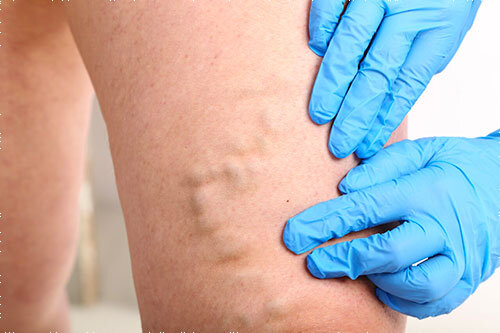Varicose Vein Pain: Symptoms, Relief, and Treatments
Varicose veins are swollen, enlarged, twisted veins. They often appear in blue or dark purple color, on the legs and feet.
Not all varicose veins are visible; sometimes they can be buried deep in the body. It requires the skill and experience of a board-certified vein specialist to diagnose these invisible varicose veins.
Symptoms of varicose veins:
Leg Pain
Symptoms of varicose veins worsen over time and with prolonged sitting or standing. Many patients mistake the symptoms for a normal sign of aging or over-exercising.
Pain Caused by Varicose Veins
Varicose veins are a common cause of leg pain, leg heaviness and leg aching. Patients experience different degrees of pain associated with varicose veins.
One condition that causes pain is phlebitis, which happens when varicose veins become inflamed and form a blood clot. Phlebitis is indicated by pain, heat and discoloration in the problematic area.
Sometimes a venous ulcer may develop as varicose veins are left untreated. The built-in pressure results in ulcers that can cause extreme pain.
Swelling in the legs is a common symptom linked to varicose veins. The pressure in your veins has built up so much that blood leaks out in the tissue around your damaged vein. Swollen ankles and legs cause great discomfort, especially while sleeping.
Varicose Vein Pain Relief
If you are experiencing any symptoms of varicose veins or are suffering from varicose vein pain, it’s highly recommended that you should see a vein specialist. Vein disease should be taken seriously as it can pose a life-threatening health issue.
Find a vein treatment center near me.
Here are some conservative or home remedies for varicose vein relief.
Elevate your legs: Putting your legs above your heart before going to sleep can promote blood flow.
Stretching: If you have to sit or stand for long times at work, stretching is important to keep the blood pumping.
Exercise: A 20-minute exercise can help vein issues. Walking, jogging and yoga are the best low-intensive exercises that one can try to get the blood moving and help relieve varicose vein pain.
Diet: You are what you eat, so adjusting your daily diet can play an important role in helping varicose veins pain. Drinking more water, reducing salt consumption, eating more fiber and taking vitamin supplements are some items that you can start with.
Wear compression stockings: Compression hose can provide relief to varicose veins as it prevents swelling and boosts blood circulation.
Schedule a free vein screening with a vein doctor who can diagnose your symptoms and determine the treatment plan for you. Many patients try home remedies long before meeting the doctor, but vein problems often worsen over time regardless of home remedies.
Varicose veins don’t always require treatments. Depending on the nature and condition of varicose veins, the doctor will recommend non-invasive procedures such as:
Endovenous Laser Ablation: Ablation uses laser heat to seal the faulty veins. The procedure is in-office and is painless after the doctor will use a local anesthetic to numb the area.
Sclerotherapy: The doctor injects foam into the varicose veins to cause veins to spasm, scar, and clot. Varicose veins will disappear over time.
Are Painful Varicose Veins Dangerous?
Painful varicose veins are an indication, and you should see a vein specialist immediately to understand the cause of the pain. Some varicose veins conditions are not visible, so if you have any unknown pain, aching, swelling or fatigue, it’s worth seeing the vein doctor for an evaluation. At Physicians Vein Clinics we offer 12 convenient vein clinics throughout South Dakota, Minnesota and Iowa.

